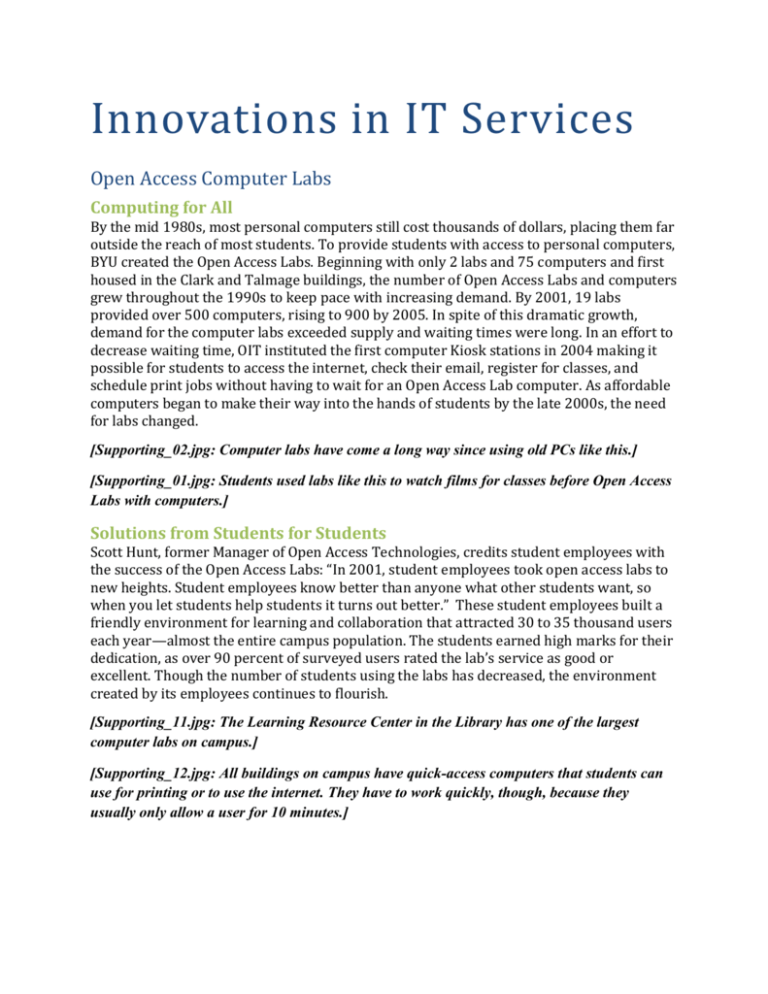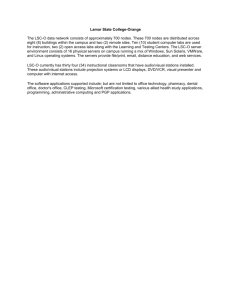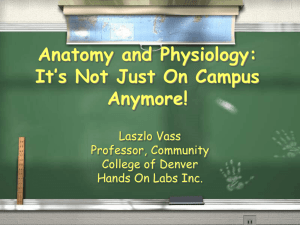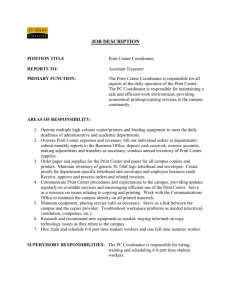Supporting Students proof v10
advertisement

Innovations in IT Services Open Access Computer Labs Computing for All By the mid 1980s, most personal computers still cost thousands of dollars, placing them far outside the reach of most students. To provide students with access to personal computers, BYU created the Open Access Labs. Beginning with only 2 labs and 75 computers and first housed in the Clark and Talmage buildings, the number of Open Access Labs and computers grew throughout the 1990s to keep pace with increasing demand. By 2001, 19 labs provided over 500 computers, rising to 900 by 2005. In spite of this dramatic growth, demand for the computer labs exceeded supply and waiting times were long. In an effort to decrease waiting time, OIT instituted the first computer Kiosk stations in 2004 making it possible for students to access the internet, check their email, register for classes, and schedule print jobs without having to wait for an Open Access Lab computer. As affordable computers began to make their way into the hands of students by the late 2000s, the need for labs changed. [Supporting_02.jpg: Computer labs have come a long way since using old PCs like this.] [Supporting_01.jpg: Students used labs like this to watch films for classes before Open Access Labs with computers.] Solutions from Students for Students Scott Hunt, former Manager of Open Access Technologies, credits student employees with the success of the Open Access Labs: “In 2001, student employees took open access labs to new heights. Student employees know better than anyone what other students want, so when you let students help students it turns out better.” These student employees built a friendly environment for learning and collaboration that attracted 30 to 35 thousand users each year—almost the entire campus population. The students earned high marks for their dedication, as over 90 percent of surveyed users rated the lab’s service as good or excellent. Though the number of students using the labs has decreased, the environment created by its employees continues to flourish. [Supporting_11.jpg: The Learning Resource Center in the Library has one of the largest computer labs on campus.] [Supporting_12.jpg: All buildings on campus have quick-access computers that students can use for printing or to use the internet. They have to work quickly, though, because they usually only allow a user for 10 minutes.] OIT’s Printing Services When Printers were Giants Printers used to be almost as colossal as the mainframes that powered them. Originally located in the Smith Family Living Center, and the size of several home refrigerators combined, BYU’s first printer, the IBM 7030, was responsible for printing most student documents. Before that, grade reports were printed using a 402 punch card machine that could only print 100 lines per minute. The IBM 7030 was revolutionary because it could print 600 lines per minute, helping the University to become vastly more efficient. The new technology was not without glitches, however, and computing employees worked tirelessly—sacrificing many nights and weekends—debugging programs to get grades printed on time for the new semester. After years of dealing with the shortcomings of the 7030, the university added a 1403 line impact printer, which printed an amazing 1200 lines per minute. Centralized printing, for all its strengths, also had its weaknesses. One night, while trying to load a 1403 printer, things went horribly wrong for computing employees, Norm Wright and Don Engstrom. Don recalls, “I set up the printer and had everything in place, but Norm didn’t have the paper in yet. Norm hollered across, ‘Are you ready?’ and I said ‘yeah.’ So we pressed the start button and paper came flying out of the machine about four or five feet above it, just shooting out. There was one button to stop the machine out of the seven buttons, so I just started pressing all of them. Norm ran over and finally pushed the right button to make it stop. There was a mound of paper, a huge haystack!” [Supporting_07.jpg: An old printer from the mainframe days.] [Supporting_06.jpg: Workers had to carefully monitor the printer to prevent mishaps.] [Supporting_04.jpg: An employee doing a print job with the mainframe in the background.] Printing Spreads Across Campus As enrollment grew to over 30,000 students in the 1990s, printing requirements for the University skyrocketed. In order to cater to this demand, the 600 line printer and 1200 line printer had to run simultaneously. As desktop computing became available, many departments across campus needed local printing capability, and with the help of computing services, began to install their own printers. With this decentralization, printing services were more readily available, but campus users were faced with a confusing array of billing procedures, pricing models, and usage policies. BYU’s modern printing network emerged in the mid 1990s, when BYU installed a printing network developed by Pharos, Inc. The program, created by a company in New Zealand, charged students low rates to print from campus printers using their Signature Cards. Rather than having to deal with a confusing array of different networks and systems, students simply had to select the printer they wanted to print from. By 2003, students could send their printing using their net ID and by 2007 they could send print jobs from any computer in the world provided it was connected to the Internet. By 2012, printing jobs could even be sent from a mobile device. [Supporting_10.jpg: Printing kiosks have Pharos touch screens to select printing jobs, like this one.] [Supporting_08.jpg: Students can print to printers like this from any computer on campus.] CSRs to the Rescue As computing moved from the centralized mainframe to the Personal Computer (PC), computer support was also decentralized, necessitating the creation of a new role: the Computer Support Representative (CSR) in 1991. Brad Stone who created the CSR program in 1991 recalls, “BYU had smart people all over campus that knew a lot about specific topics. Our goal was to link these people together so that their shared knowledge and expeience could be accessed by all.” When first introduced, the CSR program “assigned” a CSR to every full-time employee at BYU—usually based within their college or department. When faced with a computer problem, employees could simply call their personal CSR to receive help. If this “first level” support could not solve the issue, the CSR could tap the greater CSR community for advice. Failing that, CSRs could call third-party vendors for a solution. This distributed model of support continues to operate across campus. The same email list that was established over 20 years ago helps CSRs today to find answers to questions. Though many of the procedures have stayed the same, the program has matured significantly since its inception. Now, ten CSRs form a core “CSR Advisory Committee,” which, in collaboration with OIT, considers ways to optimize equipment purchases, software licensing, and technology initiatives to meet the needs of the campus community through the rest of the CSRs. [Supporting_15.jpg: CSRs regularly receive orientations on new processes.] IT Training: Creating a Technically Literate Community IT Training began in the late 1980s as a training program for students and was held in the basement of the Talmage Building. Relia Smith, then Manager of OIT Training, describes the approach of the first classes: “...the training was organized to be a kind of boot camp, where, for two weeks, every day, several hours a day, people would come to these training classes to learn about computers.” Classes were later expanded to students and faculty, but because the program had to be self-sustaining, the courses cost students $10—a price which most were not able or willing to pay. Impressed with the program and its results, the University decided to subsidize the training by the mid 1990s, making them available at no cost to students, faculty, and staff. In addition, they expanded the training space to two classrooms one located in the Jesse Knight Building, and another in the Harold B. Lee Library. In 2011, over 23 unique classes were taught, over 4,000 patrons enrolled and 95 percent of the courses were taught by student employees. In addition to educating students and staff about how to use new programs and technology tools, Relia Smith explained that the “training programs also help to smooth out the rough patches when new technology is introduced. Today, there are over 50 training programs specialized for students and staff.” [Supporting_09.jpg: IT Training has its own department in the Harold B. Lee Library.] [Supporting_13.jpg: IT Training classrooms look much like this room, with the teacher performing the tutorials on a projected screen.] Campus Operators and the Service Desk Connecting the Dots for Concerned Callers BYU’s first consolidated technical support call center was formed in 1998, when Telecommunications, University Computing, and Media Services joined together. The Call Center consisted of two separate divisions: one division was in charge of ordering parts and services, while the other division was in charge of fixing problems. Because callers were frequently confused about whom to call for what, the two groups were consolidated into a single Call Center in the mid 1990s. Today the OIT Service Desk provides support for everything OIT-related, with separate lines for faculty and students and another group, the Campus Operators, act as a general information desk, dealing with a wide range of calls, from help with research papers to dating advice. Day in the Life of a Campus Operator 1. One person calls in and asks “Is it true that people can walk on a sidewalk and suddenly blow up for no reason. Does that really happen?” 2. Another seeks help on a research paper: “Tell me how the renaissance came about, I have a paper due tomorrow.” 3. Yet more questions on personal problems: “Where are my shoes?” 4. Somebody drops a dog off at Lost and Found. Distressed Lost and Found calls the Service Desk to figure out what to do with it. 5. A distraught freshman guy calls, asking help on how to meet girls. The service desk rarely gets calls from girls asking the reverse question. 6. Somebody asks for cooking help: “How do I bake a potato? I have someone coming over for dinner, and I don’t know what to do.”





